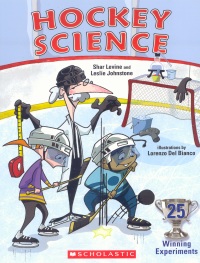| ________________
CM . . . . Volume XIX Number 9 . . . . November 2, 2012
excerpt:
Hockey Science is the third in a series of Scholastic Canada books written by Shar Levine and Leslie Johnstone. Similar to Scary Science: 25 Creepy Experiments and Snowy Science: 25 Cool Experiments, Levine and Johnstone have compiled a surprising set of activities that will certainly appeal to readers with an interest in sports or science. They begin with physical science investigations of ice, friction, potential energy, and motion and then move into an unexpected set of meaningful physiological experiments that focus upon the physical fitness and agility of hockey players. Readers learn how it's possible to have ice rinks in locations where it never gets cold, why the Zamboni doesn't "erase" or smudge the painted lines, how to differentiate slow ice from fast ice, and why hockey sticks are taped and hockey pucks are frozen. They also find out that NHL players are expected to be able to balance on wobble boards, to run about 3000 meters in twelve minutes, and to make high vertical jumps, "impressive long jumps", and to have fast reaction times. Each of the "25 Winning Experiments" begins with a question that arises out of an interesting fact or observation. This is followed by a list of necessary materials and step-by-step directions for carrying out the experiment. At the end of each experiment, Levine and Johnstone include a paragraph with the heading "What Happened?" that assists all experimenters in understanding the science behind their observational and/or measured data. Moreover, in 13 of the 25 experiments, interesting historical or contemporary scientific information is provided in text-boxes labeled "Cool Facts. Examples include archeological evidence for skates made of animal bones being used approximately five thousand years ago and adding charcoal or volcanic ash to a gym bag to absorb the odor of "ripe" sports clothing and equipment. Each experiment, whether one page or two pages in length, is illustrated with cartoon-like drawings of a brown-haired boy in a turquoise and teal hockey jersey and a girl with a pony tail of red hair who wears a purple and gold jersey. On 11 of the 48 pages of the book, illustrator Lorenzo Del Bianco has also included a chinless referee with a tuft of white hair, an enormous white moustache, bowless spectacles on a very pointy nose and wearing a white lab coat. He is reminiscent of the stereotypical scientist, albeit with a black and white striped shirt. In addition to a table of contents and glossary, Levine and Johnstone include reminders to readers about safety and the need to ask an adult for permission before trying any experiment. There is also a "Note to Parents, Teachers and Coaches" urging that the learning about the science in hockey will help some children improve their game and others "to appreciate how a pro makes it look so easy to score a goal or block a shot." Highly Recommended. Barbara McMillan is a teacher educator and a professor of science education in the Faculty of Education, the University of Manitoba, in Winnipeg, MB.
To comment
on this title or this review, send mail to cm@umanitoba.ca.
Copyright © the Manitoba Library Association. Reproduction for personal
use is permitted only if this copyright notice is maintained. Any
other reproduction is prohibited without permission.
NEXT REVIEW |
TABLE OF CONTENTS FOR THIS ISSUE
- November 2, 2012.
AUTHORS |
TITLES |
MEDIA REVIEWS |
PROFILES |
BACK ISSUES |
SEARCH |
CMARCHIVE |
HOME |
